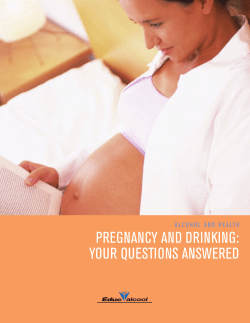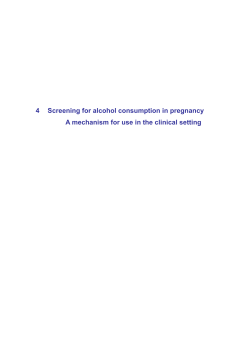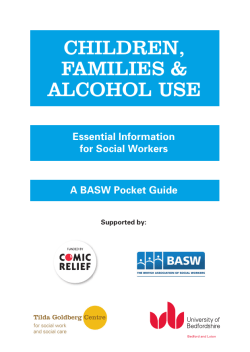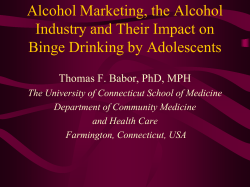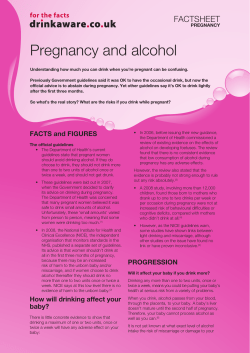
ALCOHOL HANGOVER
A L C O H O L A N D H E A LT H ALCOHOL HANGOVER TABLE OF CONTENTS ISBN 978-2-923548-37-1 Legal deposit 2012 Foreword Introduction The symptoms of hangover The causes of hangover Risk factors for hangover Consequences and remedies Conclusion 1 2 3 4 6 7 8 A L C O H O L A N D H E A LT H ALCOHOL HANG OVE R 1 FOREWORD Year in and year out, across Quebec, some people who drink wake up “the morning after” with a pounding headache, a queasy stomach and a fuzzy tongue. Veisalgia is the little-known medical term for this condition, but the rest of us call it a hangover. Consider this: There was an airline pilot who showed up for work the morning after an evening of heavy drinking, and even after a good night’s sleep was still in no condition to take the controls. And every summer, at swimming pools and lakes across the province, lifeguards and experienced swimmers find they are not quite alert after partying the night before, despite their sense that they have slept well. So is it possible that, even after “sleeping it off,” even after all the alcohol you’ve drunk has been metabolized by your body, even if your blood alcohol level is back to zero, you might still not be in full possession of your faculties and that excessive drinking has had extended effects? This report is intended to demystify the phenomenon of the hangover, to separate myth from fact about this very unpleasant result of abusive drinking. We’ll examine the symptoms, the causes, and the risk factors, and briefly review the often underestimated consequences, i.e. complications, of a hangover. At the end, we’ll offer information on how to prevent hangovers, insofar as it is possible to provide a succinct recipe. Of course, the best—and ultimately the only—way to prevent hangover is never to drink to excess. Getting really drunk, even just once, is once too often. It pays to remember that, no matter what the circumstances, moderation is always in good taste. The Éduc’alcool Board of Directors INTRODUCTION The most recent epidemiological data from the Institut de la Statistique du Québec (2011) drawn from the Canadian Community Health Survey (CCHS) shows that, among Quebecers aged 12 and over, 26% of men and 11% of women have had five drinks or more on a single occasion at least once in the previous year. The percentages are significantly higher among young people. A full 40% of 18 to 24-year-olds say they have drunk abusively in the previous year. What’s disturbing is that a longitudinal analysis of the data shows that excessive drinking is on the rise. In 2011, 18% of Quebecers 12 and older said they had drunk to excess, whereas only 11% said so ten years ago. In the latest Éduc’alcool study, 9% of drinkers in Quebec said they usually have at least five drinks on days when they drink. Of this group, nearly half (4%) usually have at least eight drinks. With regard to low-risk drinking guidelines, 27% of women said they have had more than three drinks on a single occasion at least once a month, while 37% of men said they have had more than four drinks on a single occasion at least once a month1. Based on these statistics, we can postulate that nearly one Quebec drinker in every ten suffers from a hangover on a fairly regular basis. Indeed, the latest research shows that approximately 75% of those who drink to excess will have a hangover 2. About 25% of drinkers do not display hangover symptoms after drinking heavily. This is confirmed by numerous surveys and experiments. The difference would appear to be primarily genetic, but the data is not conclusive. 1 2 Educ’alcool, 2012. Harburg, Gunn, Gleiberman, DiFranceisco, & Schork, 1993; Howland et al., 2008; Prat, Adan, & Sanchez-Turet, 2009; Pristach, Smith, & Whitney, 1983. A L C O H O L A N D H E A LT H ALCOHOL HANG OVE R 3 1. THE SYMPTOMS OF HANGOVER In the scientific literature, hangover is generally described as a malaise manifested by a constellation of biological, physiological and affective symptoms. These can be severe enough to impair function. The discomfort begins when blood alcohol content starts to drop and reaches a peak when it is back to zero. The unpleasantness associated with hangover rarely lasts more than 24 hours. Hangover symptoms are associated with blood alcohol content, which is determined primarily by three things: time, weight and sex. The distribution of alcohol in the blood is influenced by the ratio of fat to lean tissue in the body, which explains why two people may weigh the same and drink the same amount but have a different blood alcohol content. Age is also a factor. Hence, blood alcohol content calculations are approximate3. Éduc’alcool has developed a blood alcohol content (BAC) calculator that shows how BAC changes from the first drink until all alcohol has been completely eliminated from the body (available on the App store and the Android Market). According to Prat et al. (2009), the most commonly reported hangover symptoms fall into eight main categories. First there are the general effects: fatigue, depression, distress and tremendous thirst. People also commonly report nociceptive symptoms, such as muscle pains or cramps, and headaches. The most unpleasant and inconvenient symptoms include gastrointestinal disturbances, such as a loss of appetite, stomach ache, nausea, vomiting and diarrhea. Hangovers are often accompanied by increased activity in the sympathetic nervous system, which results in increased systolic blood pressure, rapid heart rate (tachycardia), palpitations, tremors and perspiration. In practice, the secondary effects of an overwhelmed sympathetic nervous system are often observed. For example, in people with atrial fibrillation, increased activity of the sympathetic nervous system can cause such stress to the heart that water may accumulate in the lungs (pulmonary edema). People who are prone to panic attacks are also vulnerable to increased anxiety related to sympathetic nervous system activity resulting from a hangover. Hangover also produces sensory-perceptual symptoms, such as dizziness and a hyper-sensitivity to sound and light. Since alcohol metabolism also affects sleep, another category of symptoms includes a general reduction in the amount of sleep and, paradoxically, an increase in slow-wave sleep. 3 Cardot, 2003. The last two categories include cognitive and psychopathological symptoms. Studies have shown that hangover affects attention, concentration and short-term memory. It can also create a deficit in visual-spatial and psychomotor skills, and cause anxiety, depression and irritability. 2. THE CAUSES OF HANGOVER Hangover may well be one of the least-documented alcohol-related subjects. However, in light of recent studies that underscore the sizable social and economic costs associated with it4, hangover is becoming a more popular research topic. Internationally recognized scientists have recently come together to create the Alcohol Hangover Research Group, whose goals include determining the pathology of alcohol hangover, examining the role of genetics in the phenomenon and exploring risk factors that could aggravate symptoms5. ✻ 2.1.1 Dehydration Obviously, the tremendous thirst associated with hangover is the result of dehydration 7. So are aching muscles and a throbbing head. When the body is dehydrated, it will draw water from any available source, including the brain. When it does this, the brain atrophies somewhat and the meninges (the protective covering around the brain) shrinks accordingly. The shrinking is what causes the headaches. Dehydration also means a serious loss of electrolytes, which can explain the cramps and muscle pains that generally accompany a hangover 8. Based on the research to date and an exhaustive review of the biological and medical literature on the subject6, it is now possible to group the causes of alcohol hangover into two main categories: indirect and direct. Indirect causes are the dehydration, low blood sugar and sleep disturbance resulting from excessive drinking. The direct cause is the production of acetaldehyde. Why is it called a hangover? While some believe it refers indelicately to “hanging over” the commode, it would appear more likely that the term was coined to describe the “leftover” or after-effect of drinking. 2.1 Dehydration, low blood sugar and sleep disturbance Excessive drinking assaults just about every part of the body, and organs under attack have to defend themselves. But the body’s physiological defense mechanisms lead to dehydration and low blood sugar. That shortage of water and sugar are what explain the particular discomfort of a hangover. 7 4 Verster et al., 2010. 5 Verster et al., 2010. 6 Penning, van Nuland, Fliervoet, Olivier, & Verster, 2010; Prat et al., 2009; Verster et al., 2010. The ethanol in alcoholic beverages finds its way to the brain and affects the pituitary gland. This leads to a reduction in the secretion of the anti-diuretic hormone whose role is to control hydration. More precisely, the kidneys no longer reabsorb enough water from the urine and therefore the body eliminates more water than it absorbs. 8 Penning et al., 2010. A L C O H O L A N D H E A LT H ALCOHOL HANG OVE R 5 ✻ 2.1.2 Low blood sugar A significant number of hangover symptoms are also those of hypoglycemia. This is no coincidence. Most of the alcohol a person drinks is processed by the liver, a remarkable organ that, among other things, produces glucose. But the liver can’t make glucose Lack of glucose = while it’s busy processing alcohol. Glucose is the functional problems and primary source of energy for metabolism, and the substance most likely to affect the brain. A lack abnormal brain activity. of glucose causes the brain to function abnormally, which is why, for several hours after drinking too much, a person will feel weak, tired, dizzy, anxious and depressed, and have difficulty concentrating and seeing clearly. LIVER In theory, everyone who drinks to intoxication will suffer temporarily from hypoglycemia. In practice, is it a specific problem for the very young who have little body fat or who have not eaten for more than 24 hours, and for regular drinkers who eat little or nothing while they drink. All are particularly vulnerable because their liver glycogen stores are very low. It should also be noted that the body compensates for a lack of glucose by producing other forms of energy, such as fatty acids. A higher concentration of fatty acids in the blood reduces blood pH, which, in turn, causes a set of symptoms associated with alcohol hangover9. ✻ 2.1.3 Sleep disturbance Studies have shown that one of the main reasons people feel so poorly the morning after getting drunk is the sleep disturbance caused by excessive drinking10. Alcohol makes you sleepy, but it also alters the sleep cycle. Specifically, it can cause insomnia, make you wake up repeatedly during the night and exacerbate sleep disturbances. That’s why people can feel so tired and not in full control of their cognitive capacities the day after heavy drinking. Nobody sleeps well after tying one on. 9 10 Penning et al., 2010 Prat, Adan, Pérez-Pãmies, & Sãnchez-Turet, 2008; Verster & Roehrs, 2007. 2.2 Acetaldehyde production As mentioned above, most of the alcohol a person drinks is processed by the liver. In so doing, the liver produces the enzyme alcohol dehydrogenase, which turns the alcohol into acetaldehyde, a very toxic substance. A high concentration of acetaldehyde has a variety of effects on the body, including reddening of the face, sweating, nausea, vomiting and tachycardia (accelerated heart rate). Given the similarity between these symptoms and those of alcohol hangover, some researchers hypothesize that the discomfort of hangover is a direct result of the metabolism of alcohol by the liver 11. According to Penning et al. (2010), the production of acetaldehyde is one of the only factors that explains both the presence and severity of hangover symptoms. 11 Swift & Davidson, 1998; Wiese, Shlipak, & Browner, 2000. A L C O H O L A N D H E A LT H ALCOHOL HANG OVE R 6 3. RISK FACTORS FOR HANGOVER 3.1 Congeners and impurities Obviously, the primary risk factor associated with alcohol hangover is excessive drinking. The incidence and severity of symptoms increases with the amount of alcohol consumed. That’s why it is so important to remember the low-risk drinking guidelines: on special occasions, women can have three drinks and men, four12. Separate episodes of alcohol abuse can have different consequences, even if the amount of alcohol is identical. The general consensus among researchers now is that the severity of hangover symptoms can be explained by congeners, i.e. chemical compounds found in alcoholic beverages, such as methanol, histamine or polyphenols13. It is suspected that methanol and its degradation products—formaldehyde and formic acid—may be the cause of the headaches, thirst, sweating and dizziness that drinkers may experience. It is therefore believed that dark spirits, which contain more methanol than clear ones, may produce stronger hangover symptoms. Nonetheless, the incidence and intensity of hangover can vary from one person to the next, even if they drink exactly the same amount. The main risk factors identified to date are listed below. Similarly, alcoholic drinks that contain high levels of impurities or preservatives may bring on hangover symptoms even when only moderate amounts are consumed. For example, zinc and other metals are sometimes added to alcoholic beverages as artificial sweeteners or to enhance flavour. That’s why artificially sweetened drinks will produce stronger hangover symptoms than drinks sweetened with real fruit juice. It also explains why some people report feeling sicker the day after an evening of drinking sweet cocktails. 12 Butt et al., 2011; Educ’alcool, 2011; Stockwell, Butt, Beirness, Glicksman, & Paradis, 2011. 13 Verster et al., 2010. ALCOOL ET SANTÉ ALCOOL ET LE N DE MAI NS DE VE I LLE 7 3.2 Psychological vulnerability 4. CONSEQUENCES AND REMEDIES As noted above, about 25% of drinkers never suffer from hangover, no matter how much they drink. Why? Research on the subject is still in its infancy and the phenomenon is still very poorly understood. But one hypothesis is that this may be due to psychosocial factors. Studies by Harburg and his colleagues (1993) have shown a significant connection between drinkers’ psychosocial state and the severity of their hangover symptoms. In one study of 1,104 drinkers who had reported being “tipsy, high or drunk,” a correlation was shown between feelings of guilt about drinking, neurosis, anger, depression or negative life events and the severity of hangover symptoms. A hangover is an obvious indication of an episode of abusive drinking. We can therefore conclude that people who report frequent hangovers are at risk for developing the disorders and diseases associated with abusive drinking, all of which are very well documented14. However, little is known as yet about the immediate and longterm health effects of hangover. The Alcohol Hangover Research Group has noted the importance of developing methodologies that would eventually allow researchers to obtain reliable measurements of the effects of hangover on the health of drinkers15. In short, the incidence and intensity of hangover symptoms are not due solely to objective causes; they might also be explained by subjective factors distinct to the individual drinker at a particular moment. This may be another reason why researchers note such variations in hangover response from one drinker to the next. 3.3 Alcohol and tobacco The association between episodic drinking and occasional smoking is well known. Many social or weekend smokers develop a sudden and strong urge to smoke when they drink excessively. Similarly, people who have quit smoking often start again during an evening of heavy drinking. These phenomena can be explained by the pharmacological interaction between alcohol and tobacco, which manifests as an intense physical need to smoke. Unfortunately, smoking while drinking can make hangover symptoms worse. According to Parnell, West and Chen (2006), nicotine delays gastric emptying, which means more alcohol is metabolized and less is absorbed by the small intestine. As a result, smokers seeking the intoxicating effects of alcohol have to drink more. That leads to the production of more acetaldehyde and greater toxicity, which aggravates the symptoms of dehydration and low blood sugar. 14 15 see The Effects of Abusive Drinking, Éduc’alcool, 2007. Verster et al., 2010). A L C O H O L A N D H E A LT H ALCOHOL HANG OVE R 8 Nonetheless, when it comes to reducing the unpleasant symptoms of alcohol hangover, a very specific warning can be issued. Headache is a symptom reported by almost 90% of people suffering from hangover16, but taking acetaminophen (Tylenol) for the pain is not advisable for everyone. Acetaminophen is tolerated by occasional drinkers who may drink too much on a particular occasion, but it is strictly contraindicated for people with an alcohol dependency (alcoholics) who have been diagnosed with liver problems. Clinical studies show that in such cases, the interaction between alcohol and acetaminophen significantly increases the risk of liver toxicity and may cause liver lesions, even when the medication is taken the next day17. For some people, therefore, a hangover headache is a “punishment” they just have to live with. 16 17 Depending on individual sensitivity, combining alcohol with acetylsalicylic acid (Aspirin) or ibuprofen (Advil, Motrin) may also be a bad idea. Alcohol can cause irritation or even inflammation of the mucous lining of the stomach. In people who are prone to gastro-intestinal problems, these medications can exacerbate the irritating effects of alcohol. In fact, the only safe way to treat the pain and discomfort of a hangover is to practice healthy living: exercise to increase oxygen supply, rehydrate by drinking plenty of water, and eat lightly. After that, only time will help. Penning et al., 2010. Amar, 2007. CONCLUSION For more than 20 years, Éduc’alcool has been keeping Quebecers informed about the benefits of moderate drinking. At the same time, the organization has continued to repeat the message that excessive drinking is unacceptable because of the risk to oneself and to others. The subject of this report—a topic discussed less frequently—is that excessive drinking is dangerous, even when blood alcohol content is back to zero. In fact, drinking to intoxication produces a host of symptoms, which, in turn, can lead to a number of serious problems. When you’re hung over, you feel badly. Sometimes very badly. And when you have a headache, are sweating and trembling and suffering from vision and concentration problems, it is just as dangerous as being drunk. Under such circumstances, it is absolutely ill-advised and irresponsible to drive, operate machinery or tools, engage in dangerous physical activity, assume responsibility for the safety of others or make important decisions. This warning is intended for anyone who drinks, but young people in particular should beware. To date, it is still not known whether there is a significant connection between age and the severity of hangover symptoms18. However, we do know that young people tend to get drunk more than older people, which means they suffer more frequently from hangover. We also know that a significant number of young people have seasonal jobs that involve physical activity and the safety of others. Think of camp counsellors, sports instructors and lifeguards, for example. For someone with a job like that, a hangover is not merely unpleasant, it is downright dangerous. Éduc’alcool therefore reminds everyone that the only way to stay in full possession of your faculties is to follow the low-risk drinking guidelines. Also, you are more likely to avoid a hangover by drinking good-quality alcohol, rather than something artificially sweetened that contains more congeners and impurities. And it’s better to stay away from certain types of alcoholic beverages that, even when taken in moderation, have a greater potential for producing unpleasant and inconveniencing symptoms. Last but not least, don’t forget that moderation is always in good taste. 18 Verster et al., 2010. IN THE SAME COLLECTION: The reports in Éduc’alcool’s Alcohol and Health series are well-researched and easy to read. Each one gets straight to the point and is a valuable health, education and information resource. All of them may be downloaded from the Éduc’alcool website www.educalcool.qc.ca or ordered by calling 1-888-ALCOOL1. ALCOHOL AND THE HUMAN BODY LOW-RISK DRINKING: 2 3 4 0 An explanation of what happens to alcohol as it passes through the body and the effects it produces. A basic guide to the rules of low-risk drinking for men and women. THE EFFECTS OF MODERATE AND REGULAR ALCOHOL CONSUMPTION THE EFFECTS OF ABUSIVE DRINKING A review of the research on how moderate, regular alcohol consumption affects human health. A review of the physiological and psychological effects of abusing drinking. The consequences of both chronic and occasional excessive drinking are highlighted. ALCOHOL AND OLDER PEOPLE ALCOHOL COMBINATIONS A description of the effects of alcohol on people 65 and older. Includes valuable advice for seniors, their families, friends and caregivers. A brochure explaining the beneficial, harmful and downright dangerous effects of combining alcohol with various other substances or activities. PREGNANCY AND DRINKING: YOUR QUESTIONS ANSWERED THE EFFECTS OF EARLY ALCOHOL USE Straight-forward answers to frequently asked questions about drinking during pregnancy and breast-feeding, for pregnant woman and those who might become pregnant. A brochure that examines the harmful effects of early alcohol use and explains the basic reasons why young people should not have unrestricted access to alcohol. ALCOHOL AND MENTAL HEALTH ACKNOWLEDGEMENTS Monograph on the effects of alcohol on mental health. Explains the connections and interactions between mental health disorders and problem drinking and provides useful information and advice. Éduc’alcool would like to thank Ms. Catherine Paradis, Ph.D., head researcher for Éduc’alcool and a member of Concordia University’s Lifestyle and Addiction Research Laboratory, for her rigorous approach and invaluable effort in simplifying the data. Thanks also go to Mr. Pierre Guérette, M.D., emergency physician at Centre hospitalier universitaire de Sherbrooke, for his excellent contribution in revising the final version of this publication. If you have a comment about this publication or want to order more copies, contact Éduc’alcool. Téléphone: 1-888-ALCOOL1 (1-888-252-6651) Courriel : info@educalcool.qc.ca www.educalcool.qc.ca VERSION FRANÇAISE DISPONIBLE SUR DEMANDE.
© Copyright 2025
